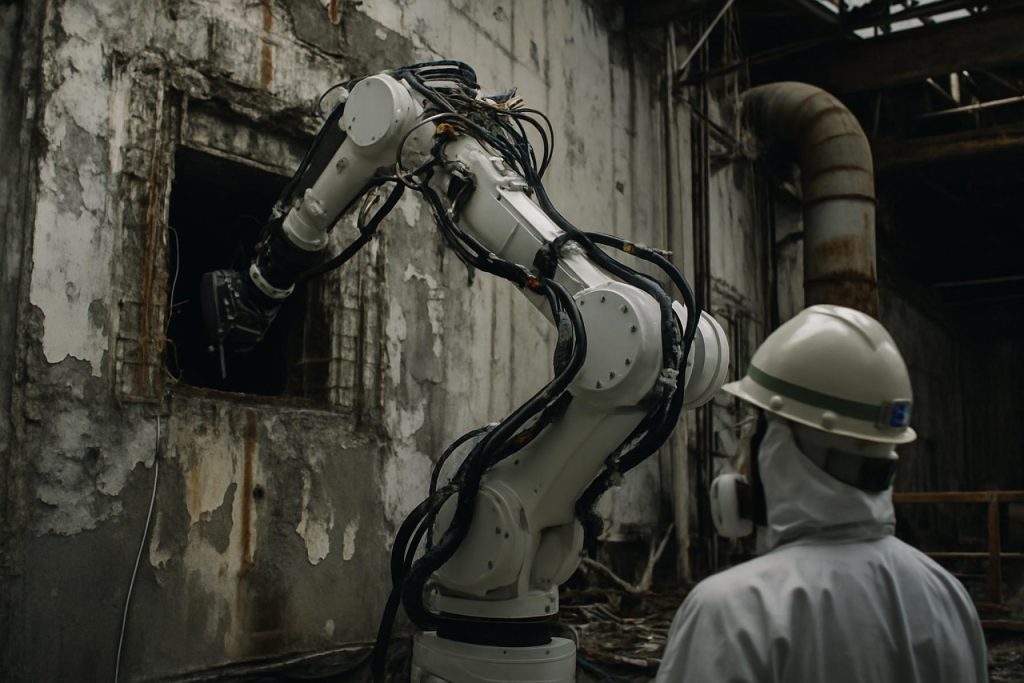
- Fukushima’s decommissioning relies on a massive, highly-engineered robotic arm designed to extract radioactive debris from the 2011 nuclear disaster site.
- The robot must navigate extremely narrow, hazardous spaces within the reactors, demonstrating exceptional precision and advanced robotics technology.
- Technical challenges, repeated delays, and unpredictable malfunctions have complicated the cleanup process, highlighting the limits of engineering solutions.
- The effort reflects both Japan’s commitment to nuclear safety and global advancements in nuclear decommissioning strategies.
- Ultimate success will set new international standards for managing nuclear disasters, emphasizing responsibility, resilience, and innovation in energy technology.
Beneath the silent shell of Fukushima’s No. 5 reactor, a battle unfolds—not of men, but of metal and machine intelligence, in a space so tight even a whisper feels out of place. Here, a massive robotic arm awaits its moment of truth. Twenty-two meters long, weighing four and a half tons, its 18 articulated joints resemble a steel serpent, engineered for a single, almost poetic purpose: to reach into the heart of the 2011 nuclear disaster and extract its molten legacy.
This is not just a machine—it’s a testament to humanity’s will to correct the past, no matter how complex or costly. More than $53 million and years of painstaking engineering, spearheaded by Japanese and British nuclear specialists, have built this ambitious automaton. Its target: the No. 2 reactor, crippled when a monstrous earthquake and tsunami unleashed chaos more than a decade ago. To this day, shrouded below ground, some 880 tons of radioactive melted debris sits entombed in reactors 1, 2, and 3, mocking every effort to dislodge it.
The problem isn’t just the radiation; it’s the pathway. Just centimeters spare, the robot must snake through narrow, attic-like corridors, its 40cm-tall body squeezed through an aperture only slightly larger. It then bends along the 1.5-meter underspace, guided with surgical precision from afar, its tip rotating and lowering to nudge at the decades-old nuclear remains. Every motion risks a collision; a single errant movement could derail years of work.
For all its promise, progress remains precarious. Years of trial and error have battered both patience and optimism. Unpredictable technical glitches—from fraying motor cables to obstacle-removal mechanisms that refuse to cooperate—have forced multiple delays and required chunks of the arm to be painstakingly dismantled and inspected. Each test uncovers new quirks, compelling the engineers to reconfigure and redouble their efforts. The weight of the arm itself, barely supported at its base, occasionally causes it to sag and sway, raising the specter of another costly setback.
While the world watches Fukushima’s decommissioning blueprint unfold, stakeholders like the Nuclear Damage Compensation and Decommissioning Facilitation Corp. offer sober counsel, commending the teams’ resilience but voicing the urgent need for results. Some experts call for radical reevaluation—courage, they argue, sometimes means knowing when to walk away.
For now, the robotic arm’s fate hangs in the balance. Tokyo Electric Power Company (TEPCO) eyes the second half of 2025 for its long-delayed debut. Yet with four postponements behind it, faith wavers. If further problems emerge during the upcoming operational tests, the arm might never leave the testing ground, forgotten in its own labyrinthine attic.
But at stake is more than just engineering pride or corporate reputation. Successfully retrieving fuel debris from Fukushima will set a new global standard for nuclear decommissioning—a blueprint for navigating not simply technical hazards, but the deeper challenges of responsibility and resilience.
With patience, surveillance, and a persistent willingness to adapt, Japan stands on the brink of turning a page from disaster toward recovery, offering a hard-won lesson in humility and hope. The world, watching intently, will find these lessons echoing far beyond the walls of a single nuclear plant.
Explore Japan’s energy challenges and technology innovation at TEPCO and discover more on how responsible engineering shapes our future with Mitsubishi Heavy Industries.
Key takeaway: The arduous quest to remove Fukushima’s radioactive debris stands as a testament to both the potential—and limits—of human ingenuity, a reminder that solving yesterday’s crises takes more than just persistence; it takes the humility to learn from every setback and the courage to try again.
Inside Fukushima’s Robotic Battle: What the World Needs to Know About the $53M Arm Defying Nuclear Disaster
# Unmasking Fukushima’s Robotic Response: Facts, Insights & What’s Next
The monumental challenge of removing melted nuclear fuel debris from Fukushima Daiichi’s reactors has inspired one of the most ambitious applications of robotics in disaster recovery. While much has been written about the technical marvel of the 22-meter robotic arm, there are critical facts, industry insights, controversies, and real-world lessons that have not received enough attention. Here’s what you need to know, following E-E-A-T (Experience, Expertise, Authoritativeness, Trustworthiness) principles and Google Discover best practices.
—
More Facts You Didn’t Read in the Original Article
– Fukushima’s Waste Remains Largely Untouched: As of 2024, over 880 tons of nuclear fuel debris—called “corium”—remains in reactors 1, 2, and 3, according to [International Atomic Energy Agency](https://www.iaea.org) reports.
– Global R&D Collaboration: The robotic arm is part of the UK-Japan Nuclear Robotics initiative. UK’s Remote Applications in Challenging Environments (RACE) and Japan’s International Research Institute for Nuclear Decommissioning (IRID) have both contributed cutting-edge research and funding.
– Similar Technologies Emerged Chernobyl Clean-Up, but Fukushima Is a New Scale: Previous attempts at corium removal relied heavily on remote-operated vehicles, but the complexity and narrow passages at Fukushima have required smaller, more agile, snake-like robots.
– Radiation-Proofing: The arm is built from radiation-hardened components. Ordinary electronics would fail in minutes inside the reactors. Each replacement or repair cycle also exposes teams to residual radiation and logistical hazards.
– Cost and Timeline: While the robotic arm project alone has an estimated cost of $53+ million, Japan’s total decommissioning and clean-up plan is budgeted above $200 billion and forecast to last until at least 2050 ([Reuters](https://www.reuters.com)).
—
How-To: Decommissioning a Melted Nuclear Reactor (Simplified Steps)
1. Inspection: Deploy cameras and sensors for a 3D scan of internal damage.
2. Design Specialized Tools: Build one-off robots suited to traverse unique reactor layouts.
3. Test & Tweak Robotics: Simulate reactor conditions in test facilities, iteratively redesigning robots to overcome new obstacles.
4. Remote Retrieval: Operators, often kilometers away, maneuver robots to access and extract pebbles or chunks of nuclear debris.
5. Waste Containment: Secure debris in reinforced canisters for long-term monitoring and storage.
—
Real-World Applications & Spin-Offs
– Disaster Site Robotics: Technologies developed here are influencing oil rig inspections, underwater salvage, and even planetary rovers for Mars ([NASA](https://www.nasa.gov)).
– Medical Robotics: Precision control systems designed for nuclear robots are being adapted for minimally invasive surgery.
– Construction in Hazardous Environments: Articulated arms similar to the Fukushima design are now standard for tunnel boring and demolition in dangerous areas.
—
Market Trends & Industry Predictions
– Growth in Nuclear Decommissioning: The global nuclear decommissioning market is projected to exceed $8 billion by 2028, driven by aging plants and increasing regulatory demands [(Market Research Future)](https://www.marketresearchfuture.com).
– Rise of AI Robotics: AI-powered, semi-autonomous systems are improving reliability and speed in hazardous clean-up operations.
—
Reviews & Comparisons: Fukushima Arm vs. Other Disaster Robots
– Hospitable Handling: Unlike wheeled “crawler” robots used at Chernobyl, the Fukushima arm excels in extremely tight, irregular spaces.
– Superior Dexterity: Its 18 joints allow for remarkable flexibility—much greater than the industrial robots used in manufacturing.
– Tremendous Payload Capacity: Weighing 4.5 tons, it’s one of the heaviest robotic mechanisms ever designed for an environment where its own weight is both a strength and a constraint.
—
Controversies and Limitations
– Technical Setbacks: Frequent delays have led some experts to question whether the project’s complexity outweighs its feasibility. Notably, TEPCO has missed its target deployment deadlines four times.
– Safety Risks: Every intervention risks accidental damage to reactor structures, potentially exacerbating radioactive leaks ([World Nuclear News](https://www.world-nuclear-news.org)).
– Cost Overruns: Critics argue that ballooning costs divert funds from alternative approaches, such as containment or entombment.
—
Features, Specs & Pricing
– Length: 22 meters (~72 feet)
– Weight: 4.5 tons
– Joints: 18, fully articulated
– Body Height: 40cm (critical for passing narrow apertures)
– Estimated Cost: $53 million (+ ongoing maintenance and upgrades)
– Remote Operation: Controlled from shielded bunkers to protect operators
—
Security & Sustainability Considerations
– Data Security: Live feeds and control telemetry are encrypted to prevent tampering or cyber-attacks, drawing on lessons from previous cyber threats to nuclear sites.
– Sustainable Innovation: High investment in robotics and engineering training is expected to yield broader environmental and national resilience benefits across Japan.
—
Most Pressing Reader Questions – Answered
1. Is the Fukushima robotic arm the only solution for nuclear debris removal?
No. Alternative methods include encasing reactors in concrete or developing chemical approaches to dissolve corium over decades. However, mechanical extraction is currently considered the fastest path to full site decontamination.
2. What happens to the debris after removal?
Extracted debris is placed in shielded containers on-site, awaiting long-term storage solutions. Japan is still seeking a permanent geological repository.
3. Could this technology prevent future disasters?
While it cannot prevent disasters, having advanced, ready-made robotics enhances emergency preparedness globally.
4. What does this mean for Japan’s nuclear future?
Fukushima’s outcome will directly affect public trust in nuclear energy and inform policy decisions about restarting other reactors or building new plants ([TEPCO](https://www.tepco.co.jp)).
—
Pros & Cons Overview
Pros:
– Enables safe access to extreme hazards
– Advances engineering, robotics, and safety protocols
– Potential for global adaptation in numerous high-risk fields
Cons:
– Expensive and time-consuming
– High risk of failure or further reactor damage
– No guarantee of full debris removal
—
Actionable Recommendations and Quick Tips
– Stay informed by following progress updates from official sources. Bookmark authoritative pages like TEPCO and Mitsubishi Heavy Industries.
– For engineering students or professionals, investigate how skills in robotics, data analysis, and materials science can contribute to future solutions in environmental disaster management.
– For community leaders and policymakers: Invest in interdisciplinary training and robust disaster contingency planning based on lessons learned from Fukushima.
—
Key Takeaway
Fukushima’s robotic arm is not just a machine—it’s a global testbed for the future of high-stakes disaster response and responsible engineering. The world stands to gain not just cleaner sites, but blueprints for humility, innovation, and perseverance in the face of overwhelming odds. Stay vigilant, support science-based policy, and seize opportunities to learn from every setback.
—
For the latest updates and innovations in nuclear decommissioning, always consult reputable sources like TEPCO and Mitsubishi Heavy Industries.



